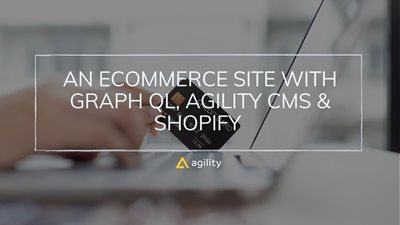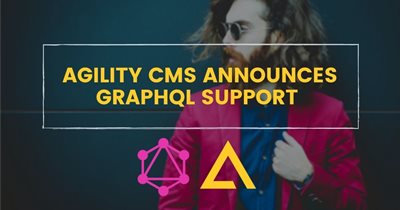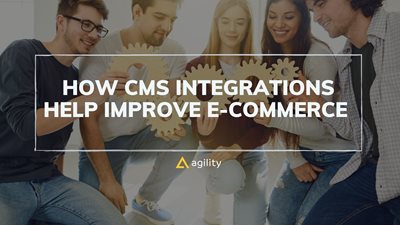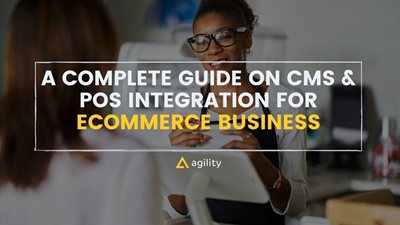Jamstack Architecture With GraphQL, Agility CMS & Shopify
A gradual step-by-step guideline on incorporating GraphQL, Shopify and Agility CMS


Technological proliferation necessitates that industrial companies pay monumental attention to technology and other digitalization trends.
Thus, taking a cue from the above, CEOs and decision-makers must understand or have the slightest knowledge about these modern trends. To help CEOs and companies stay abreast and equipped with widespread tech knowledge, Agility CMS, in a webinar meeting with Anant Jhingran and Carlos Eberhardt, discussed Graph QL API, Jamstack, and E-commerce in full-fledged.
The webinar is available here.
To fully understand the implications and intertwined relationship between these three concepts, they need to be conversant with their conceptual definitions. Then, we would see a gradual step-by-step guideline on incorporating these pivotal elements. First, let's see what an e-commerce platform—both backend and front-end—is all about.
Ecommerce with Jamstack-ready CMS

The Ecommerce platform is a virtual representation of all that previously happened physically. However, it does not mean there are no physical transactions. Instead, it implies that virtual transactions are becoming more popular— replacing physical modes of transacting— due to the increasing rate of e-commerce platforms. The e-commerce platform is a pivotal technological improvisation that ensures customers can buy goods and services via an interactional and B2B experience.
The platform embodies vital and well-detailed data for customers to influence their decision-making. A good e-commerce platform range includes APIs or out-of-the-box (OOB) to enable customers' self-service, B2B, or interactive commerce experience.
An e-commerce platform has two core parts—the front end and the backend. These two parts are fully worked on by developers and programmed to function to every command made by e-commerce businesses or customers.
Jamstack Architecture
- The Front-end:
The front-end is the part users see and interact with. The enticing outlook of an e-commerce platform grants users a stroll over the interface. A UI engineer and designer build it. They ensure the website does not take long to load and it is quick to react to commands.
- The Backend:
The backend is the part users don't see and are not conversant with. Backend developers say it is not as attractive as the front-end. However, if the backend isn't supportive of the e-commerce website, no e-commerce website in the world will be able to stand firm in the competitive market.
'Fundamentally, an e-commerce website is built off at least two, possibly seven or more backends,' said Anant Jhingran in the webinar discussion with Agility CMS, 'The backend of an e-commerce website are divided into two core components: The Content Management System and The Merchant System.
The content management system is typically in control of the marketing team that deals with what the look and feel of your ecommerce website are. It is not just about images. It includes all the content, blogs, marketing, material, and audience selections. While the merchant system deals with actual transactions taking place.'
Both systems need to align and work hand-in-hand to help an e-commerce website function properly. The merchant system embodies two other systems: the inventory and delivery systems. These systems work simultaneously to ensure that your e-commerce website is up and running.
There is a possibility that you will need different systems to sustain your e-commerce website functionality. These systems are where the data powering your e-commerce website emanates from. Therefore, there is unavoidable to manage all these arrows and connectivities.
Notably, one needs to pay attention to the content management system. 'In my view, the content management system is the most important in your e-commerce website because it controls your customers' experience. It controls health promotion, segmentation, audience targeting, etc.' Anant mentioned.
As a developer or business owner, you need to opt for a headless CMS. Before the headless CMS, there was the traditional content management system at the beginning of web development. The conventional CMS manages content by storing content, images, HTML, CSS, and others into a giant bucket. Thus, it became unfeasible to use the content again because it has been mixed with codes.
The Headless CMS is the perfect solution to the problem found in the traditional CMS. The evolution of digital platforms has made it impossible for conventional CMS to keep up. Now, digital media thirst for more flexible solutions available in the headless CMS.
Agility CMS is a perfect example of a headless CMS. A headless CMS is a type of backend content management system where the content body is not attached to the presentation layer—the head. Content embodied in a headless CMS depends on APIs for flawless display across multiple devices.
The merchant system also plays an essential role in the backend of an e-commerce website. However, this data splurging from the e-commerce website backend—content management system and merchant system—is challenging. As a result, many e-commerce business owners and developers have had difficulties controlling customers' experiences.
Remember, the customers' experience is all that reflects on the website's front-end. Because of this large volume of data in the backend and the need to add richer data, it has become complex— this is where GraphQL comes in to help, as mentioned in the webinar with Agility CMS.
Static Site Generator- GraphQL

According to research by Gartner, GraphQL has emerged as an alternative to REST APIs. It provides flexibility to API consumers but brings new challenges to API delivery. Application technical professionals responsible for API design, integration, and management must assess GraphQL's benefits and impact on API governance and security.
'The GraphQL ecosystem has been thriving over the last couple of years. We have seen it expand from the front-end developer ecosystem where it began to penetrate the API ecosystem, including adoption by technology vendors and enterprises' said Gary Oliffe, a Gartner analyst.
For Anant Jhingran, GraphQL makes building many of these experiences— content management system, the merchant system, and several others— much easier and less complicated. As Carlos pointed out, many of us were working with REST APIs. Then, we fell in love with GraphQL because it makes it easy for front-end people to get the correct information,' Anant Jhingran added.
GraphQL is otherwise referred to as an API query language, which offers an adequate and comprehensible description of your API. It ensures that clients get the chance to request what they need and receive precisely what they have asked for.
GraphQL facilitates keeping up with the evolution of APIs, thereby empowering critical developer apparatus. It is a language that describes the best way to request data; it also serves as a means to deliver data to a user from a server.
For instance, with GraphQL, you can run a query like this:
customer (email: “john.doeexample.com”) {
orders (status: “undelivered”) {
deliveryStatus {
expectedDate
signatureRequired
}
}
An Ecommerce Jamstack Ecosystem with Headless CMS

In the webinar, Stepzen uses a framework from Jamstack where Agility CMS controls the content management system, the merchant system is managed by Shopify, and the overall control of the e-commerce jamstack backend is under the control of GraphQL. The webinar is available here. The distinct feature of GraphQL is the use of schemas— which makes it more strict than the REST APIs.
GraphQL helps to run a query from Shopify— managing the merchant system, and Agility CMS— controlling the content management system, to reveal data requested from the website's front-end by users. Carlos takes us through a demo via the webinar with Agility CMS.
stepzen > queries.graphql
returns a product via a sequence — first a query to Shopify products, then to Agility CMS then ”””
productsRest: [ProductRest]
@sequence(
steps: {
{ query: “shopifyProducts”}
{ query: “agilityProductByShopifyId”}
{ query: “collect” }
(These queries imply requests for data about the Shopify products and agility products by Shopify. Then, you proceed:)
]
)
collect(
title: String
audience: String
description: String
image: String
createAt: String
admin_graphql_api_id: String
type: String
slug: String
agilityId: ID
shopifyId: ID
Hero: Boolean
): ProductRest @connector( type: “echo”)
So enter collect, request for all the data queried. GraphQL helps string data together, so it is possible to get data via just one command. This makes it relatively easy and straightforward for developers and e-commerce business owners.
Also, with GraphQL, it is easier to be specific and uncomplicated. As a user, you can ask for particular data about products, and you will get it without getting waylaid by a stockpile of needless data.
Wrapping Up
This is a typical example of how fast innovation is catching up with humanity. GraphQL has offered a less complicated way to ensure data in the e-commerce website backend is appropriately managed and controlled via Shopify and Agility CMS. As a result, developers are relieved of the stress of understanding the complexities of data and the difficulties in stringing them together to improve the website's front-end.
Furthermore, GraphQL via stepzen reveals that it is possible to have plug-ins readily update data as time changes. So, in the end, developers and e-commerce business owners have nothing to lose. They have to stay updated and conversant with technological trends.

About the Author
Odukoya Adeniyi is a Freelance writer with Agility CMS. He is passionate about technology, blockchain, Metaverse and other 21st century trends. He is a poet. His chapbook, Preserve This Light, was published by PoetsInNigeria. Reach out to him on twitter and LinkedIn.
View Related Resources

Agility CMS Announces GraphQL Support

How CMS integrations help improve your Ecommerce site

A Complete Guide On CMS & POS Integration For Ecommerce Business
Agility CMS + Best In Class Ecommerce helps you increase your sales
Agility CMS plus your Ecommerce platform can do more together
Learn More
